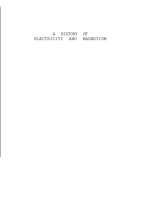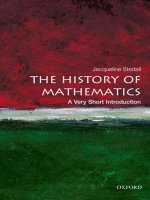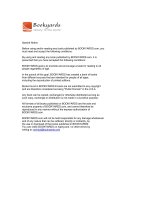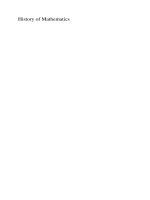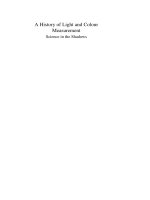A History of Mathematics, by Florian Cajori docx
Bạn đang xem bản rút gọn của tài liệu. Xem và tải ngay bản đầy đủ của tài liệu tại đây (2.26 MB, 556 trang )
The Project Gutenberg EBook of A History of Mathematics, by Florian Cajori
This eBook is for the use of anyone anywhere at no cost and with
almost no restrictions whatsoever. You may copy it, give it away or
re-use it under the terms of the Project Gutenberg License included
with this eBook or online at www.gutenberg.org
Title: A History of Mathematics
Author: Florian Cajori
Release Date: January 24, 2010 [EBook #31061]
Language: English
Character set encoding: ISO-8859-1
*** START OF THIS PROJECT GUTENBERG EBOOK A HISTORY OF MATHEMATICS ***
Produced by Andrew D. Hwang, Peter Vachuska, Carl Hudkins
and the Online Distributed Proofreading Team at
transcriber’s note
Figures may have been moved with respect to the
surrounding text. Minor typographical corrections
and presentational changes have been made without
comment.
This PDF file is formatted for screen viewing, but
may be easily formatted for printing. Please consult
the preamble of the L
A
T
E
X source file for instructions.
A HISTORY OF MATHEMATICSA HISTORY OF
M A T H E M A T I C S
BY
FLORIAN CAJORI, Ph.D.
Formerly Professor of Applied Mathematics in the Tulane University
of Louisiana; now Professor of Physics
in Colorado College
“I am sure that no subject loses more than mathematics
by any attempt to dissociate it from its history.”—J. W. L.
Glaisher
New York
THE MACMILLAN COMPANY
LONDON: MACMILLAN & CO., Ltd.
1909
All rights reserved
Copyright, 1893,
By MACMILLAN AND CO.
Set up and electrotyped January, . Reprinted March,
; October, ; November, ; January, ; July, .
Norwood Pre&:
J. S. Cushing & Co.—Berwick & Smith.
Norwood, Mass., U.S.A.
PREFACE.
An increased interest in the history of the exact sciences
manifested in recent years by teachers everywhere, and the
attention given to historical inquiry in the mathematical
class-rooms and seminaries of our leading universities, cause
me to believe that a brief general History of Mathematics will
be found acceptable to teachers and students.
The pages treating—necessarily in a very condensed form—
of the progress made during the present century, are put forth
with great diffidence, although I have spent much time in
the effort to render them accurate and reasonably complete.
Many valuable suggestions and criticisms on the chapter on
“Recent Times” have been made by Dr. E. W. Davis, of the
University of Nebraska. The proof-sheets of this chapter have
also been submitted to Dr. J. E. Davies and Professor C. A.
Van Velzer, both of the University of Wisconsin; to Dr. G. B.
Halsted, of the University of Texas; Professor L. M. Hoskins, of
the Leland Stanford Jr. University; and Professor G. D. Olds,
of Amherst College,—all of whom have afforded valuable
assistance. I am specially indebted to Professor F. H. Loud, of
Colorado College, who has read the proof-sheets throughout.
To all the gentlemen above named, as well as to Dr. Carlo
Veneziani of Salt Lake City, who read the first part of my work
in manuscript, I desire to express my hearty thanks. But in
acknowledging their kindness, I trust that I shall not seem to
v
lay upon them any share in the responsibility for errors which
I may have introduced in subsequent revision of the text.
FLORIAN CAJORI.
Colorado College, December, 1893.
TABLE OF CONTENTS
Page
INTRODUCTION . . . . . . . . . . . . . . . . . . . . . . . 1
ANTIQUITY . . . . . . . . . . . . . . . . . . . . . . . . . . 5
The Babylonians . . . . . . . . . . . . . . . . . . . . . 5
The Egyptians . . . . . . . . . . . . . . . . . . . . . . 10
The Greeks . . . . . . . . . . . . . . . . . . . . . . . . 17
Greek Geometry . . . . . . . . . . . . . . . . . . . . . 17
The Ionic School . . . . . . . . . . . . . . . . . . . 19
The School of Pythagoras . . . . . . . . . . . . . . 22
The Sophist School . . . . . . . . . . . . . . . . . . 26
The Platonic School . . . . . . . . . . . . . . . . . 33
The First Alexandrian School . . . . . . . . . . . . 39
The Second Alexandrian School . . . . . . . . . . . 62
Greek Arithmetic . . . . . . . . . . . . . . . . . . . . . 72
The Romans . . . . . . . . . . . . . . . . . . . . . . . . 89
MIDDLE AGES . . . . . . . . . . . . . . . . . . . . . . . . 97
The Hindoos . . . . . . . . . . . . . . . . . . . . . . . 97
The Arabs . . . . . . . . . . . . . . . . . . . . . . . . . 116
Europe During the Middle Ages . . . . . . . . . . . 135
Introduction of Roman Mathematics . . . . . . . . 136
Translation of Arabic Manuscripts . . . . . . . . . . 144
The First Awakening and its Sequel . . . . . . . . . 148
MODERN EUROPE . . . . . . . . . . . . . . . . . . . . . . 160
The Renaissance . . . . . . . . . . . . . . . . . . . . . 161
Vieta to Descartes . . . . . . . . . . . . . . . . . . . 181
Descartes to Newton . . . . . . . . . . . . . . . . . 213
Newton to Euler . . . . . . . . . . . . . . . . . . . . 231
vii
TABLE OF CONTENTS. viii
Page
Euler, Lagrange, and Laplace . . . . . . . . . . . . 286
The Origin of Modern Geometry . . . . . . . . . . . 332
RECENT TIMES . . . . . . . . . . . . . . . . . . . . . . . 339
Synthetic Geometry . . . . . . . . . . . . . . . . . . 341
Analytic Geometry . . . . . . . . . . . . . . . . . . . 358
Algebra . . . . . . . . . . . . . . . . . . . . . . . . . . 367
Analysis . . . . . . . . . . . . . . . . . . . . . . . . . . 386
Theory of Functions . . . . . . . . . . . . . . . . . . 405
Theory of Numbers . . . . . . . . . . . . . . . . . . . 422
Applied Mathematics . . . . . . . . . . . . . . . . . . 435
BOOKS OF REFERENCE.
The following books, pamphlets, and articles have been used in
the preparation of this history. Reference to any of them is made
in the text by giving the respective number. Histories marked
with a star are the only ones of which extensive use has been
made.
1. G
¨
unther, S. Ziele und Resultate der neueren Mathematisch-
historischen Forschung. Erlangen, 1876.
2. Cajori, F. The Teaching and History of Mathematics in the U. S.
Washington, 1890.
3. *Cantor, Moritz. Vorlesungen
¨
uber Geschichte der Mathematik.
Leipzig. Bd. I., 1880; Bd. II., 1892.
4. Epping, J. Astronomisches aus Babylon. Unter Mitwirkung von
P. J. R. Strassmaier. Freiburg, 1889.
5. Bretschneider, C. A. Die Geometrie und die Geometer vor
Euklides. Leipzig, 1870.
6. *Gow, James. A Short History of Greek Mathematics. Cambridge,
1884.
7. *Hankel, Hermann. Zur Geschichte der Mathematik im
Alterthum und Mittelalter. Leipzig, 1874.
8. *Allman, G. J. Greek Geometry from Thales to Euclid. Dublin,
1889.
9. De Morgan, A. “Euclides” in Smith’s Dictionary of Greek and
Roman Biography and Mythology.
10. Hankel, Hermann. Theorie der Complexen Zahlensysteme.
Leipzig, 1867.
11. Whewell, William. History of the Inductive Sciences.
12. Zeuthen, H. G. Die Lehre von den Kegelschnitten im Alterthum.
Kopenhagen, 1886.
ix
A HISTORY OF MATHEMATICS. x
13. *Chasles, M. Geschichte der Geometrie. Aus dem Franz
¨
osischen
¨
ubertragen durch Dr. L. A. Sohncke. Halle, 1839.
14. Marie, Maximilien. Histoire des Sciences Math´ematiques et
Physiques. Tome I.–XII. Paris, 1883–1888.
15. Comte, A. Philosophy of Mathematics, translated by W. M.
Gillespie.
16. Hankel, Hermann. Die Entwickelung der Mathematik in den
letzten Jahrhunderten. T
¨
ubingen, 1884.
17. G
¨
unther, Siegmund und Windelband, W. Geschichte der
antiken Naturwissenschaft und Philosophie. N
¨
ordlingen, 1888.
18. Arneth, A. Geschichte der reinen Mathematik. Stuttgart, 1852.
19. Cantor, Moritz. Mathematische Beitr
¨
age zum Kulturleben der
V
¨
olker. Halle, 1863.
20. Matthiessen, Ludwig. Grundz
¨
uge der Antiken und Modernen
Algebra der Litteralen Gleichungen. Leipzig, 1878.
21. Ohrtmann und M
¨
uller. Fortschritte der Mathematik.
22. Peacock, George. Article “Arithmetic,” in The Encyclopædia
of Pure Mathematics. London, 1847.
23. Herschel, J. F. W. Article “Mathematics,” in Edinburgh
Encyclopædia.
24. Suter, Heinrich. Geschichte der Mathematischen Wissenschaf-
ten. Z
¨
urich, 1873–75.
25. Quetelet, A. Sciences Math´ematiques et Physiques chez les
Belges. Bruxelles, 1866.
26. Playfair, John. Article “Progress of the Mathematical and
Physical Sciences,” in Encyclopædia Britannica, 7th edition,
continued in the 8th edition by Sir John Leslie.
27. De Morgan, A. Arithmetical Books from the Invention of
Printing to the Present Time.
28. Napier, Mark. Memoirs of John Napier of Merchiston.
Edinburgh, 1834.
29. Halsted, G. B. “Note on the First English Euclid,” American
Journal of Mathematics, Vol. II., 1879.
BOOKS OF REFERENCE. xi
30. Madame Perier. The Life of Mr. Paschal. Translated into
English by W. A., London, 1744.
31. Montucla, J. F. Histoire des Math´ematiques. Paris, 1802.
32. D
¨
uhring E. Kritische Geschichte der allgemeinen Principien der
Mechanik. Leipzig, 1887.
33. Brewster, D. The Memoirs of Newton. Edinburgh, 1860.
34. Ball, W. W. R. A Short Account of the History of Mathematics.
London, 1888, 2nd edition, 1893.
35. De Morgan, A. “On the Early History of Infinitesimals,” in the
Philosophical Magazine, November, 1852.
36. Bibliotheca Mathematica, herausgegeben von Gustaf Enestr
¨
om,
Stockholm.
37. G
¨
unther, Siegmund. Vermischte Untersuchungen zur Geschich-
te der mathematischen Wissenschaften. Leipzig, 1876.
38. *Gerhardt, C. I. Geschichte der Mathematik in Deutschland.
M
¨
unchen, 1877.
39. Gerhardt, C. I. Entdeckung der Differenzialrechnung durch
Leibniz. Halle, 1848.
40. Gerhardt, K. I. “Leibniz in London,” in Sitzungsberichte der
K
¨
oniglich Preussischen Academie der Wissenschaften zu Berlin,
Februar, 1891.
41. De Morgan, A. Articles “Fluxions” and “Commercium Epis-
tolicum,” in the Penny Cyclopædia.
42. *Todhunter, I. A History of the Mathematical Theory of
Probability from the Time of Pascal to that of Laplace.
Cambridge and London, 1865.
43. *Todhunter, I. A History of the Theory of Elasticity and of
the Strength of Materials. Edited and completed by Karl
Pearson. Cambridge, 1886.
44. Todhunter, I. “Note on the History of Certain Formulæ in
Spherical Trigonometry,” Philosophical Magazine, February,
1873.
45. Die Basler Mathematiker, Daniel Bernoulli und Leonhard Euler.
Basel, 1884.
A HISTORY OF MATHEMATICS. xii
46. Reiff, R. Geschichte der Unendlichen Reihen. T
¨
ubingen, 1889.
47. Waltershausen, W. Sartorius. Gauss, zum Ged
¨
achtniss.
Leipzig, 1856.
48. Baumgart, Oswald. Ueber das Quadratische Reciprocit
¨
atsgesetz.
Leipzig, 1885.
49. Hathaway, A. S. “Early History of the Potential,” Bulletin of
the N. Y. Mathematical Society, I. 3.
50. Wolf, Rudolf. Geschichte der Astronomie. M
¨
unchen, 1877.
51. Arago, D. F. J. “Eulogy on Laplace.” Translated by B. Powell,
Smithsonian Report, 1874.
52. Beaumont, M.
´
Elie De. “Memoir of Legendre.” Translated by
C. A. Alexander, Smithsonian Report, 1867.
53. Arago, D. F. J. “Joseph Fourier.” Smithsonian Report, 1871.
54. Wiener, Christian. Lehrbuch der Darstellenden Geometrie.
Leipzig, 1884.
55. *Loria, Gino. Die Haupts
¨
achlichsten Theorien der Geometrie
in ihrer fr
¨
uheren und heutigen Entwickelung, ins deutsche
¨
ubertragen von Fritz Sch
¨
utte. Leipzig, 1888.
56. Cayley, Arthur. Inaugural Address before the British Associa-
tion, 1883.
57. Spottiswoode, William. Inaugural Address before the British
Association, 1878.
58. Gibbs, J. Willard. “Multiple Algebra,” Proceedings of the
American Association for the Advancement of Science, 1886.
59. Fink, Karl. Geschichte der Elementar-Mathematik. T
¨
ubingen,
1890.
60. Wittstein, Armin. Zur Geschichte des Malfatti’schen Problems.
N
¨
ordlingen, 1878.
61. Klein, Felix. Vergleichende Betrachtungen
¨
uber neuere geome-
trische Forschungen. Erlangen, 1872.
62. Forsyth, A. R. Theory of Functions of a Complex Variable.
Cambridge, 1893.
63. Graham, R. H. Geometry of Position. London, 1891.
BOOKS OF REFERENCE. xiii
64. Schmidt, Franz. “Aus dem Leben zweier ungarischer Mathe-
matiker Johann und Wolfgang Bolyai von Bolya.” Grunert’s
Archiv, 48:2, 1868.
65. Favaro, Anton. “Justus Bellavitis,” Zeitschrift f
¨
ur Mathematik
und Physik, 26:5, 1881.
66. Dronke, Ad. Julius Pl¨ucker. Bonn, 1871.
67. Bauer, Gustav. Ged
¨
achtnissrede auf Otto Hesse. M
¨
unchen,
1882.
68. Alfred Clebsch. Versuch einer Darlegung und W
¨
urdigung
seiner wissenschaftlichen Leistungen von einigen seiner Freunde.
Leipzig, 1873.
69. Haas, August. Versuch einer Darstellung der Geschichte des
Kr
¨
ummungsmasses. T
¨
ubingen, 1881.
70. Fine, Henry B. The Number-System of Algebra. Boston and
New York, 1890.
71. Schlegel, Victor. Hermann Grassmann, sein Leben und seine
Werke. Leipzig, 1878.
72. Zahn, W. v. “Einige Worte zum Andenken an Hermann Hankel,”
Mathematische Annalen, VII. 4, 1874.
73. Muir, Thomas. A Treatise on Determinants. 1882.
74. Salmon, George. “Arthur Cayley,” Nature, 28:21, September,
1883.
75. Cayley, A. “James Joseph Sylvester,” Nature, 39:10, January,
1889.
76. Burkhardt, Heinrich. “Die Anf
¨
ange der Gruppentheorie
und Paolo Ruffini,” Zeitschrift f
¨
ur Mathematik und Physik,
Supplement, 1892.
77. Sylvester, J. J. Inaugural Presidential Address to the Mathemat-
ical and Physical Section of the British Association at Exeter.
1869.
78. Valson, C. A. La Vie et les travaux du Baron Cauchy. Tome I.,
II., Paris, 1868.
79. Sachse, Arnold. Versuch einer Geschichte der Darstellung
willk
¨
urlicher Funktionen einer variablen durch trigonometrische
Reihen. G
¨
ottingen, 1879.
A HISTORY OF MATHEMATICS. xiv
80. Bois-Reymond, Paul du. Zur Geschichte der Trigonometrischen
Reihen, Eine Entgegnung. T
¨
ubingen.
81. Poincar
´
e, Henri. Notice sur les Travaux Scientifiques de Henri
Poincar´e. Paris, 1886.
82. Bjerknes, C. A. Niels-Henrik Abel, Tableau de sa vie et de son
action scientifique. Paris, 1885.
83. Tucker, R. “Carl Friedrich Gauss,” Nature, April, 1877.
84. Dirichlet, Lejeune. Ged
¨
achtnissrede auf Carl Gustav Jacob
Jacobi. 1852.
85. Enneper, Alfred. Elliptische Funktionen. Theorie und Ge-
schichte. Halle a/S., 1876.
86. Henrici, O. “Theory of Functions,” Nature, 43:14 and 15, 1891.
87. Darboux, Gaston. Notice sur les Travaux Scientifiques de M.
Gaston Darboux. Paris, 1884.
88. Kummer, E. E. Ged
¨
achtnissrede auf Gustav Peter Lejeune-Diri-
chlet. Berlin, 1860.
89. Smith, H. J. Stephen. “On the Present State and Prospects
of Some Branches of Pure Mathematics,” Proceedings of the
London Mathematical Society, Vol. VIII., Nos. 104, 105, 1876.
90. Glaisher, J. W. L. “Henry John Stephen Smith,” Monthly
Notices of the Royal Astronomical Society, XLIV., 4, 1884.
91. Bessel als Bremer Handlungslehrling. Bremen, 1890.
92. Frantz, J. Festrede aus Veranlassung von Bessel’s hundertj
¨
ahr-
igem Geburtstag. K
¨
onigsberg, 1884.
93. Dziobek, O. Mathematical Theories of Planetary Motions.
Translated into English by M. W. Harrington and W. J. Hussey.
94. Hermite, Ch. “Discours prononc´e devant le pr´esident de
la R´epublique,” Bulletin des Sciences Math´ematiques, XIV.,
Janvier, 1890.
95. Schuster, Arthur. “The Influence of Mathematics on the
Progress of Physics,” Nature, 25:17, 1882.
96. Kerbedz, E. de. “Sophie de Kowalevski,” Rendiconti del Circolo
Matematico di Palermo, V., 1891.
97. Voigt, W. Zum Ged
¨
achtniss von G. Kirchhoff. G
¨
ottingen, 1888.
BOOKS OF REFERENCE. xv
98. B
ˆ
ocher, Maxime. “A Bit of Mathematical History,” Bulletin of
the N. Y. Math. Soc., Vol. II., No. 5.
99. Cayley, Arthur. Report on the Recent Progress of Theoretical
Dynamics. 1857.
100. Glazebrook, R. T. Report on Optical Theories. 1885.
101. Rosenberger, F. Geschichte der Physik. Braunschweig, 1887–
1890.
A HISTORY OF MATHEMATICS.
Introduction.
The contemplation of the various steps by which mankind
has come into possession of the vast stock of mathematical
knowledge can hardly fail to interest the mathematician. He
takes pride in the fact that his science, more than any other,
is an exact science, and that hardly anything ever done in
mathematics has proved to be useless. The chemist smiles
at the childish efforts of alchemists, but the mathematician
finds the geometry of the Greeks and the arithmetic of the
Hindoos as useful and admirable as any research of to-day. He
is pleased to notice that though, in course of its development,
mathematics has had periods of slow growth, yet in the main
it has been pre-eminently a progressive science.
The history of mathematics may be instructive as well
as agreeable; it may not only remind us of what we have,
but may also teach us how to increase our store. Says De
Morgan, “The early history of the mind of men with regard
to mathematics leads us to point out our own errors; and
in this respect it is well to pay attention to the history of
mathematics.” It warns us against hasty conclusions; it points
out the importance of a good notation upon the progress of
the science; it discourages excessive specialisation on the part
of investigators, by showing how apparently distinct branches
1
A HISTORY OF MATHEMATICS. 2
have been found to possess unexpected connecting links; it
saves the student from wasting timeand energy upon problems
which were, perhaps, solved long since; it discourages him
from attacking an unsolved problem by the same method
which has led other mathematicians to failure; it teaches that
fortifications can be taken in other ways than by direct attack,
that whenrepulsed froma directassault itis well toreconnoitre
and occupy the surrounding ground and to discover the secret
paths by which the apparently unconquerable position can
be taken. [1] The importance of this strategic rule may be
emphasised by citing a case in which it has been violated. An
untold amount of intellectual energy has been expended on
the quadrature of the circle, yet no conquest has been made by
direct assault. The circle-squarers have existed in crowds ever
since the period of Archimedes. After innumerable failures
to solve the problem at a time, even, when investigators
possessed that most powerful tool, the differential calculus,
persons versed in mathematics dropped the subject, while
those who still persisted were completely ignorant of its
history and generally misunderstood the conditions of the
problem. “Our problem,” says De Morgan, “is to square the
circle with the old allowance of means: Euclid’s postulates
and nothing more. We cannot remember an instance in which
a question to be solved by a definite method was tried by
the best heads, and answered at last, by that method, after
thousands of complete failures.” But progress was made on
this problem by approaching it from a different direction and
by newly discovered paths. Lambert proved in 1761 that
INTRODUCTION. 3
the ratio of the circumference of a circle to its diameter is
incommensurable. Some years ago, Lindemann demonstrated
that this ratio is also transcendental and that the quadrature
of the circle, by means of the ruler and compass only, is
impossible. He thus showed by actual proof that which keen-
minded mathematicians had long suspected; namely, that the
great army of circle-squarers have, for two thousand years,
been assaulting a fortification which is as indestructible as the
firmament of heaven.
Another reason for the desirability of historical study is the
value of historical knowledge to the teacher of mathematics.
The interest which pupils take in their studies may be greatly
increased if the solution of problems and the cold logic of
geometrical demonstrations are interspersed with historical
remarks and anecdotes. A class in arithmetic will be pleased
to hear about the Hindoos and their invention of the “Arabic
notation”; they will marvel at the thousands of years which
elapsed before people had even thought of introducing into
the numeral notation that Columbus-egg—the zero; they
will find it astounding that it should have taken so long to
invent a notation which they themselves can now learn in a
month. After the pupils have learned how to bisect a given
angle, surprise them by telling of the many futile attempts
which have been made to solve, by elementary geometry,
the apparently very simple problem of the trisection of an
angle. When they know how to construct a square whose
area is double the area of a given square, tell them about the
duplication of the cube—how the wrath of Apollo could be
A HISTORY OF MATHEMATICS. 4
appeased only by the construction of a cubical altar double
the given altar, and how mathematicians long wrestled with
this problem. After the class have exhausted their energies
on the theorem of the right triangle, tell them the legend
about its discoverer—how Pythagoras, jubilant over his great
accomplishment, sacrificed a hecatomb to the Muses who
inspired him. When the value of mathematical training is
called in question, quote the inscription over the entrance
into the academy of Plato, the philosopher: “Let no one
who is unacquainted with geometry enter here.” Students
in analytical geometry should know something of Descartes,
and, after taking up the differential and integral calculus, they
should become familiar with the parts that Newton, Leibniz,
and Lagrange played in creating that science. In his historical
talk it is possible for the teacher to make it plain to the student
that mathematics is not a dead science, but a living one in
which steady progress is made. [2]
The history of mathematics is important also as a valuable
contribution to the history of civilisation. Human progress
is closely identified with scientific thought. Mathematical
and physical researches are a reliable record of intellectual
progress. The history of mathematics is one of the large
windows through which the philosophic eye looks into past
ages and traces the line of intellectual development.
ANTIQUITY.
THE BABYLONIANS.
The fertile valley of the Euphrates and Tigris was one
of the primeval seats of human society. Authentic history
of the peoples inhabiting this region begins only with the
foundation, in Chaldæa and Babylonia, of a united kingdom
out of the previously disunited tribes. Much light has been
thrown on their history by the discovery of the art of reading
the cuneiform or wedge-shaped system of writing.
In the study of Babylonian mathematics we begin with the
notation of numbers. A vertical wedge stood for 1, while
the characters and signified 10 and 100 respectively.
Grotefend believes the character for 10 originally to have
been the picture of two hands, as held in prayer, the palms
being pressed together, the fingers close to each other, but the
thumbs thrust out. In the Babylonian notation two principles
were employed—the additive and multiplicative. Numbers
below 100 were expressed by symbols whose respective values
had to be added. Thus, stood for 2, for 3, for 4,
for 23, for 30. Here the symbols of higher order
appear always to the left of those of lower order. In writing
the hundreds, on the other hand, a smaller symbol was placed
to the left of the 100, and was, in that case, to be multiplied
by 100. Thus, signified 10 times 100, or 1000. But
5
A HISTORY OF MATHEMATICS. 6
this symbol for 1000 was itself taken for a new unit, which
could take smaller coefficients to its left. Thus,
denoted, not 20 times 100, but 10 times 1000. Of the largest
numbers written in cuneiform symbols, which have hitherto
been found, none go as high as a million. [3]
If, as is believed by most specialists, the early Sumerians
were the inventors of the cuneiform writing, then they were,
in all probability, also familiar with the notation of numbers.
Most surprising, in this connection, is the fact that Sumerian
inscriptions disclose the use, not only of the above decimal
system, but also of a sexagesimal one. The latter was used
chiefly in constructing tables for weights and measures. It
is full of historical interest. Its consequential development,
both for integers and fractions, reveals a high degree of
mathematical insight. We possess two Babylonian tablets
which exhibit its use. One of them, probably written between
2300 and 1600 b.c., contains a table of square numbers up
to 60
2
. The numbers 1, 4, 9, 16, 25, 36, 49, are given as the
squares of the first seven integers respectively. We have next
1.4 = 8
2
, 1.21 = 9
2
, 1.40 = 10
2
, 2.1 = 11
2
, etc. This remains
unintelligible, unless we assume the sexagesimal scale, which
makes 1.4 = 60 + 4, 1.21 = 60 + 21, 2.1 = 2.60 + 1. The second
tablet records the magnitude of the illuminated portion of the
moon’s disc for every day from new to full moon, the whole
disc being assumed to consist of 240 parts. The illuminated
parts during the first five days are the series 5, 10, 20, 40,
1.20(= 80), which is a geometrical progression. From here on
the series becomes an arithmetical progression, the numbers
THE BABYLONIANS. 7
from the fifth to the fifteenth day being respectively 1.20, 1.36,
1.52, 1.8, 2.24, 2.40, 2.56, 3.12, 3.28, 3.44, 4. This table not only
exhibits the use of the sexagesimal system, but also indicates
the acquaintance of the Babylonians with progressions. Not
to be overlooked is the fact that in the sexagesimal notation
of integers the “principle of position” was employed. Thus,
in 1.4 (= 64), the 1 is made to stand for 60, the unit of
the second order, by virtue of its position with respect to
the 4. The introduction of this principle at so early a date
is the more remarkable, because in the decimal notation
it was not introduced till about the fifth or sixth century
after Christ. The principle of position, in its general and
systematic application, requires a symbol for zero. We ask,
Did the Babylonians possess one? Had they already taken the
gigantic step of representing by a symbol the absence of units?
Neither of the above tables answers this question, for they
happen to contain no number in which there was occasion to
use a zero. The sexagesimal system was used also in fractions.
Thus, in the Babylonian inscriptions,
1
2
and
1
3
are designated
by 30 and 20, the reader being expected, in his mind, to
supply the word “sixtieths.” The Greek geometer Hypsicles
and the Alexandrian astronomer Ptolemæus borrowed the
sexagesimal notation of fractions from the Babylonians and
introduced it into Greece. From that time sexagesimal frac-
tions held almost full sway in astronomical and mathematical
calculations until the sixteenth century, when they finally
yielded their place to the decimal fractions. It may be asked,
What led to the invention of the sexagesimal system? Why
A HISTORY OF MATHEMATICS. 8
was it that 60 parts were selected? To this we have no positive
answer. Ten was chosen, in the decimal system, because it
represents the number of fingers. But nothing of the human
body could have suggested 60. Cantor offers the following
theory: At first the Babylonians reckoned the year at 360 days.
This led to the division of the circle into 360 degrees, each
degree representing the daily amount of the supposed yearly
revolution of the sun around the earth. Now they were, very
probably, familiar with the fact that the radius can be applied
to its circumference as a chord 6 times, and that each of
these chords subtends an arc measuring exactly 60 degrees.
Fixing their attention upon these degrees, the division into
60 parts may have suggested itself to them. Thus, when
greater precision necessitated a subdivision of the degree, it
was partitioned into 60 minutes. In this way the sexagesimal
notation may have originated. The division of the day into
24 hours, and of the hour into minutes and seconds on the
scale of 60, is due to the Babylonians.
It appears that the people in the Tigro-Euphrates basin had
made very creditable advance in arithmetic. Their knowledge
of arithmetical and geometrical progressions has already been
alluded to. Iamblichus attributes to them also a knowledge
of proportion, and even the invention of the so-called musical
proportion. Though we possess no conclusive proof, we have
nevertheless reason to believe that in practical calculation
they used the abacus. Among the races of middle Asia,
even as far as China, the abacus is as old as fable. Now,
Babylon was once a great commercial centre,—the metropolis
